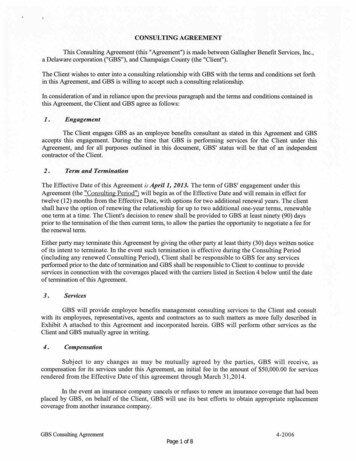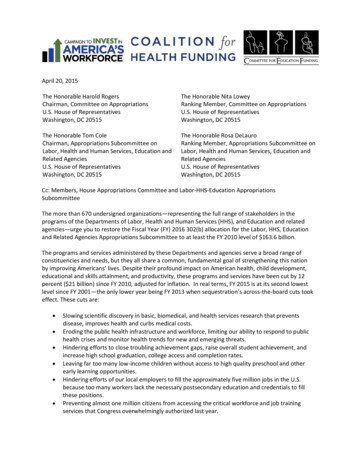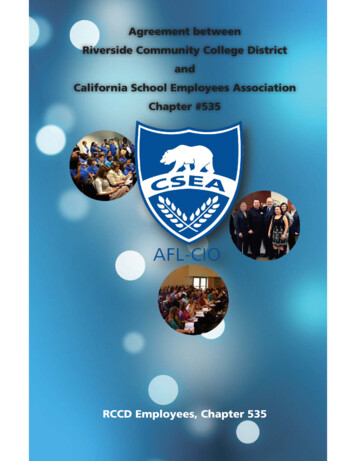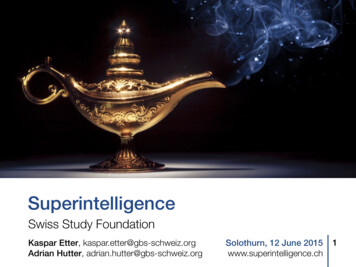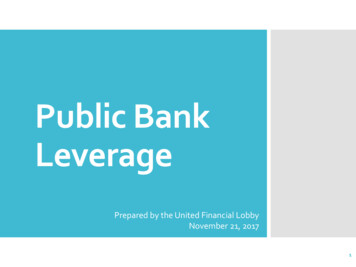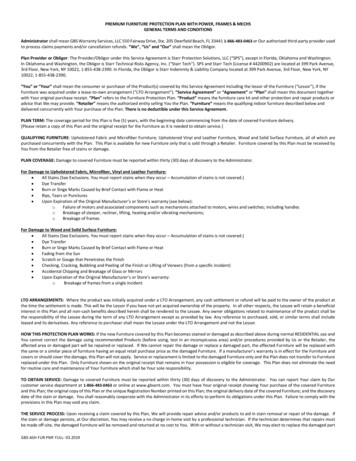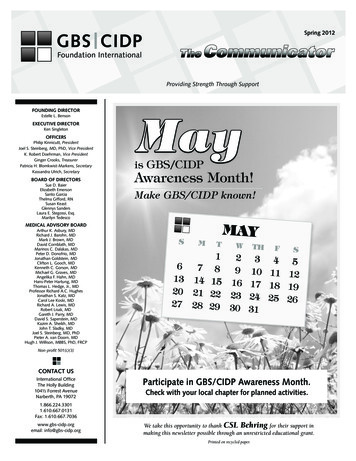
Transcription
Spring 2012Providing Strength Through SupportFOUNDING DIRECTOREstelle L. BensonEXECUTIVE DIRECTORKen SingletonOFFICERSPhilip Kinnicutt, PresidentJoel S. Steinberg, MD, PhD, Vice PresidentK. Robert Doehrman, Vice PresidentGinger Crooks, TreasurerPatricia H. Blomkwist-Markens, SecretaryKassandra Ulrich, SecretaryBOARD OF DIRECTORSSue D. BaierElizabeth EmersonSanto GarciaThelma Gifford, RNSusan KeastGlennys SandersLaura E. Stegossi, Esq.Marilyn Tedescois GBS/CIDPAwareness Month!Make GBS/CIDP known!MEDICAL ADVISORY BOARDArthur K. Asbury, MDRichard J. Barohn, MDMark J. Brown, MDDavid Cornblath, MDMarinos C. Dalakas, MDPeter D. Donofrio, MDJonathan Goldstein, MDClifton L. Gooch, MDKenneth C. Gorson, MDMichael G. Graves, MDAngelika F. Hahn, MDHans-Peter Hartung, MDThomas L. Hedge, Jr., MDProfessor Richard A.C. HughesJonathan S. Katz, MDCarol Lee Koski, MDRichard A. Lewis, MDRobert Lisak, MDGareth J. Parry, MDDavid S. Saperstein, MDKazim A. Sheikh, MDJohn T. Sladky, MDJoel S. Steinberg, MD, PhDPieter A. van Doorn, MDHugh J. Willison, MBBS, PhD, FRCPNon-profit 501(c)(3)CONTACT USInternational OfficeThe Holly Building104½ Forrest AvenueNarberth, PA 19072Participate in GBS/CIDP Awareness Month.Check with your local chapter for planned activities.1.866.224.33011.610.667.0131Fax: 1.610.667.7036www.gbs-cidp.orgemail: info@gbs-cidp.orgWe take this opportunity to thank CSL Behring for their support inmaking this newsletter possible through an unrestricted educational grant.Printed on recycled paper.
Spring 2012 GBS/CIDP Foundation InternationalRare Disease DayCelebrationMessage from the Executive DirectorCall to ActionFebruary 29thGBS/CIDP Foundation Internationaljoined in with people from all over theglobe to celebrate Rare Disease Day onthe rarest of days, February 29th. KenSingleton, Executive Director, went toBethesda, Maryland and participated inthe National Institutes of Health fifthannual Rare Disease Day with a daylong celebration and recognition of thevarious rare diseases research activitiessupported by the NIH Office of RareDiseases Research, the NIH ClinicalCenter, other NIH Institutes and Centers,the Food & Drug Administration’sOffice of Orphan Product Development(OOPD), the National Organizationfor Rare Disorders (NORD), and theGenetic Alliance. On March 1st, hejoined in with others at the FDA RareDisease Patient Advocacy Day in SilverSprings, Maryland. The purpose ofthe event was to enhance awarenessof FDA’s roles and responsibilitiesin the development of products(drugs, biologics, and devices) for thediagnosis, prevention, and/or treatmentof rare diseases and conditions.The CommunicatorPState and Federal Level AdvocacyVolunteers Neededatient advocacy is an important part of the Foundation’smission. With the upcoming implementation of theFederal Affordable Care Act, monitoring healthcarerelated legislation at the Federal and State level is morecritical than ever in ensuring access to quality and affordable healthcare for ourpatients and their families, and we could use your help.Two issues have already started to surface in State Legislatures as they startto implement the act and deal with the creation of their individual “State HealthInsurance Exchanges.”1. One troubling concept is the possible transition from a fixed co-paymentplan for prescription drugs to a co-insurance model that could result in anenormous increase in what our patients would have to pay for expensive drugtherapies like IVIG.2. Another problem is the possible adoption of a “fail first” or “step therapy”approach that would require medical personnel to use the least expensive drugor treatment procedure first upon a confirmed diagnosis. If it fails, they wouldthen continue using approved less expensive interventions until deciding touse the more expensive alternative. Since early diagnosis and treatment ofGBS, CIDP and variants is critical in limiting nerve damage, this approachcould have a devastating impact on patient rehab and recovery.It is vitally important for us to participate in the legislative process at boththe Federal and State level. If you have an interest in helping out and are willingto have your voice heard on behalf of the Foundation, we would like to hearfrom you. Our Advocacy Director Ed Gdula and the office staff will provide thetraining and all necessary materials and information.Please contact the office at info@gbs-cidp.org, (610) 667-0131 or toll free(866) 224-3301.Looking forward to you joining us in our advocacy efforts,Ken SingletonIn case you haven’t seen our newest publication, Guidelines for Physical and Occupational Therapy,check it out on our website www.gbs-cidp.org or contact the office for a copy at info@gbs-cidp.orgor 610-667-0131. Also, in the summer, look for the announcement of the publication ofGuillain-Barré Syndrome: An Acute Care Guide for Nurses and Therapists.Disclaimer Information Questions presented in the GBS/CIDP Newsletter are intended for general educational purposes only, and should not be construedas advising on diagnosis or treatment of the Guillain-Barré Syndrome or any other medical condition.Privacy Policy In response to many queries: Intrusive practices are not used by the GBS/CIDP Foundation International. It does NOT sell its mailing listnor does it make available telephone numbers! The liaisons are listed in the chapter directory with their permission. Our CIDP and Miller-Fisher Groupsshare names only after a signed permission slip is received. We are proud that none of our members has ever been solicited or sent materials other thanthose concerning GBS. We respect your privacy.
Spring 2012 GBS/CIDP Foundation InternationalThe CommunicatorAsk the DoctorJoel S. Steinberg, MD, PhD (Dr. Steinberg is a former GBS patient, Vice President ofthe Foundation’s Board of Directors and a member of the Medical Advisory Board)Relapse from GBSQuestion: Mr. RB asks abouta potential complication oraftermath of GBS that is likelyon the minds of many former GBSpatients. He expresses concerns aboutrelapse and wonders how common it is,what the symptoms are, and what can bedone about it. He relates experiencing,from time to time, tingling or numbnessin the soles of the feet, wondering ifthis is a sign that GBS is coming back.He understands that about 10% of GBSpatients have a relapse, and wonders howto distinguish tingling sensations thatpass from those that presage an attack.Reply: Mr. B raises important issues, ofnatural concern to former GBS patients.Let’s first discuss ‘relapse’.One can look upon a true ‘relapse’ asa deterioration or reversal of symptoms,in the form of recurrent weakness and/orabnormal sensations that is experiencedearly in the course of recovery fromGBS. In the typical GBS case, the patientdeteriorates, from their normal state, bydeveloping progressive weakness, usuallyaccompanied by abnormal sensations(tingling, numbness, formications [asense of worms or ants crawling underthe skin], even frank pain), over severaldays to at most four weeks, until thisdeterioration stops. In most patients,about two thirds of them, weaknessascends the body, leading to inabilityto walk and even weakness of the arms.In about a third of patients, weaknessprogresses up the body to involve thebreathing muscles, requiring mechanicalventilation, with the use of a respirator,for days to weeks. In both situations, onceweakness maximizes, the patient plateausfor hours, and barely noticeable, to daysor longer. This is followed by steadyrecovery. During this recovery, often earlyon, within its first few days to weeks, thatrelapse can occur. And this relapse, whichoccurs in perhaps 10% of patients, can besevere enough to require re-intubationand mechanical ventilation. So relapsecan be serious. Once the relapse hasplateaued, improvement of strength againresumes, often steadily. It is helpful earlyin the recovery phase, for physicians tobe on the lookout for deterioration, incase breathing collapses.After the patient has recovered,which in most people (up to 75%) can bea full recovery, there are some potentialfurther scenarios.A small percentage of ‘recovered’patients may experience ongoing fatigueand/or abnormal sensations, such astingling. Fatigue is often treated withpaced activities. Abnormal sensationsare sometimes improved with suchmedications as gabapentin (Neurontin)or pregabalin (Lyrica).Up to 3% of recovered GBS patientsmay incur a true second episode or caseof GBS.And occasionally a recovered patientmay experience a recurrence of abnormalsensations and/or weakness and think itis their GBS coming back again, whenit is actually something else. Thesepatients, essentially all patients whohave recovered from GBS and again getsensation abnormalities, warrant a newlook and evaluation of their symptoms.Do not automatically expect the recurrentsymptoms to be due to a recurrence ofGBS. Sometimes new weakness and/orsensations changes can reflect newlyevolving CIDP, the chronic cousin of GBS.Or an entirely different disorder may bedeveloping. The diagnostic possibilitiesare not that small, including diabetes,underactive thyroid gland, etc. It is oftenwise to have a physician familiar withGBS examine the patient, to look forthese various disorders that could in partmimic a recurrence of GBS.Safety of immunizationsQuestion: Should I have a flushot if I have had GBS or CIDP?Should my family members havethe flu shot also?Reply: Administration of the 1976 swineflu immunization was followed by amuch greater than expected number ofcases of GBS in recipients. This scenariohas not recurred. But that event did raiseconcerns about the safety of influenza aswell as other immunizations. The generalteaching on this matter is as follows:If an individual’s case of GBSfollowed shortly, within 6 weeks, ofhaving received a flu shot or otherimmunization, that injection shouldlikely not be given again. Otherwise,most immunizations, including the flushot are usually safe. And their benefitsusually far outweigh their risks.As to CIDP, there is no evidencethat this is triggered by flu or otherimmunizations. Since CIDP developsslowly, often over months, it is usuallyquite difficult to ascribe the disorder to aspecific event such as an immunization.In short, having had CIDP is not aknown contraindication to receivingthe flu shot.For both GBS and CIDP patientsthe decision about administeringimmunizations is best made by thefamily physician who can take intoconsideration the patients’ various othermedical issues. There is no evidence thatfamily members of former GBS and CIDPpatients are at increased risk to developthese disorders from immunizations.Therefore it will usually be safe for themto get the flu shot if they fulfill standardcriteria to receive it.Memory loss after GBSQuestion: I want know ifmemory loss is associated withGuillain-Barre Syndrome (GBS).My husband was diagnosed andhospitalized last November 3, 2011 in theNetherlands with GBS, was treated withimmunoglobulin for 6 days (approximately700 ml per day). He is now on a coursefor rehabilitation (physical therapy),has not recovered the movements wellin the hands, but in the last month hasshown some memory loss. We talk aboutsomething and then he does not rememberit. Has this to do with the disease?Reply: GBS fortunately does not affectthe brain, the site of memory. So it maybe helpful to look for other explanationsof this change. Depending in part onthe patient’s age and general medicalcondition, it may be helpful to check forthe usual causes of poor memory, such ashypothyroidism, vitamin B12 deficiency,loss of nerve cells in the brain, and soforth. A fresh look by a family physicianor neurologist may be helpful, in partby looking for new issues rather thanthe GBS.
Spring 2012 GBS/CIDP Foundation InternationalDShining Inspiration Story of Dale Torgersonof Viroqua, Wisconsinale Torgerson spent 62 daysin the hospital after beingstricken with Guillain-BarréSyndrome in February, unable towalk or feed himself and his bodyin a state of 85 percent paralysisfor weeks. He was unable to hughis wife, Brenda, or hold his threedaughters, Erin, 7, Katy Jo, 4, andMyle, 22 months. His career wasput on hold; something not easilydone as a dairy farmer. His family played board gameswith Dale in the hospital as part of his rehabilitation fromthe body-paralyzing disease. His complete recovery couldtake one to three years.At the age of 34, Dale was always healthy and rarelysuffered from any of the common illnesses. In Januarythough, he came down with a cold that held on for a coupleof weeks and left him struggling to feel better. On Feb. 10,he began having a tingling sensation in the bottom of hisfeet. At midnight on Feb. 11, he woke freezing. He felt coldas ice inside, but his body was warm to the touch on theoutside. By 3 a.m., when he was ready to head to the farmto milk, he was feeling extremely weak and thought maybehe had the flu. At the farm, Torgerson began feeling sluggishand everything seemed to be moving in slow motion. Hemanaged to finish chores, but they took twice as long asnormal to complete. He called Brenda and said he neededto go to the doctor, something he has never done in theirnine years of marriage, she said.Blood tests completed on Torgerson all came backnegative, and he was given a large dose of Benadryl tofight what doctors thought might be an allergic reaction.Brenda questioned the diagnosis, especially after hereturned home to rest and failed to show any signs ofimprovement when he woke up. Torgerson tried to shrugit off and headed back to the farm, where his conditionbegan deteriorating fast. He found himself unable to dosimple motions and was unable to climb a ladder in thebarn, feed the cows and kept clenching his fists, whichfelt like they were sleeping. “A bag of barn lime felt likeit weighed 500 pounds,” Torgerson said.In a twist of fate, a man hired to complete someinsulation work at the farm, who was also an EMT, toldTorgerson he needed to get the hospital immediately.Torgerson agreed something was wrong, but he wantedto drive himself. “I called Brenda and told her I thought Iwas dying. I couldn’t explain it, but I definitely felt like it,”Torgerson said.By the time Torgerson arrived at the hospital his healthhad taken a turn for the worse. His legs didn’t want to move, The Communicatorhis arms and face were going numband he was so weak he could barelystand. Thankfully, the physicianon call in the emergency roomrecognized Torgerson’s symptoms,after having treated another patientwith GBS years earlier. “Dale’sparalysis had advanced so far bythe time we got to La Crosse that ittook two spinal taps to finally getthe fluid they needed. His pain wasso bad, but he was too weak to even scream. I just keptpraying that he wouldn’t die,” Brenda said.Test results confirmed Torgerson was suffering fromGBS. He was placed in ICU for 16 days, where he receivedIVIG for six days. His condition continued to deterioratefor days following his admission and he slept most of thetime. His condition hit rock bottom at the end of February,during which time Torgerson dropped 30 pounds andlost all his muscle tone. His blood pressure skyrocketedmuch of the time, and his pounding heart felt like it wasbreaking right through the chest wall. He suffered a relapseon March 3, which required two more doses of IVIG. Hedeveloped a blood clot.As the road to recovery began, rehabilitation was longand extensive, requiring at least three hours of therapy aday. “I was like a kid having to learn everything all overagain, but harder since I couldn’t feel anything even if I wastouching it,” Dale said. Torgerson worked overtime on histherapy and was released from the hospital on April 15, twomonths after entering the facility. Leaving the hospital wasbittersweet for Torgerson, who was fearful he wasn’t readyto be on his own. Since that time he has made significantstrides. He still walks with a cane and he attends therapyfour days a week.Brenda awaits the day her husband can walk withouthis cane, play with their children like he did before, farmwithout fear of falling and she will never forget theiryoungest daughter, Myle, was 14 months old and took herfirst steps in life walking next to her dad, as he was learningto stand and walk all over again.Together they are trying to rebuild their lives andmove forward with their dreams, many of which havebeen put on hold for the past months. They are forevergrateful to all the people who helped them through thisdifficult time. They know the importance of family, friendsand the countless strangers who helped them when theyneeded it most. “Sometimes it takes a family to go throughsomething like this before you realize what you have.It has made me love things so much more and cherishthings daily,” Brenda said.
Spring 2012 GBS/CIDP Foundation InternationalDThe CommunicatorMay is Gbs/cidp Awareness Monthuring the month of May, in an effortto increase awareness in each of ourcommunities, we encourage everyoneto organize activities that highlight GBS,CIDP and their variants.In the past, members have sponsorededucational events, contacted politicians,and held local fundraising events.Throughout the world individuals andgroups have organized fundraising/awarenessevents such as walks, runs, bake sales, foodsales, fashion shows, afternoon teas, cocktailLetter fromSt. Odilia CatholicSchoolClass of 2012receptions, art sales, sports outings and “sitins” for those who cannot walk. The includedinsert highlights two annual events held inNorth Carolina and the Virtual Miracle MileWalk. Awareness and fundraising eventscan be big or small – what’s important isthat as a community we are able to advanceour mission in whatever way we can byeducating people about GBS and CIDP.If you are interested in participatingplease contact us at info@gbs-cidp.org,610-667-0131 or your local affiliate.February 23, 2012Dear Guillain-Barré Syndrome Foundation,Last Fall, just after school started, one of our classmates,Rachel Stowman came down with GBS. Rachel was out of schoolfor quite a while and when she was in school she missed classesdue to her many doctor appointments. Each day we witnessedthe continuing effects of GBS as Rachel struggled to walk. Shortlyafter we returned to school after Christmas break, Rachel againhad to leave school due to GBS. Throughout all of this, Rachel hasremained the same funny, outgoing and kind young woman wehave always known.Teachers have missed having Rachel in class and the studentshave missed her silliness and her friendship. As an eighth gradeclass, the students and advisors decided to donate all of the fundsraised through our annual Valegram Day activities, in Rachel’sname to the Guillain-Barré Syndrome Foundation. We sell“Valegrams” which are like Valentines but are delivered to studentsthroughout our school. The most fun part is the singing Valegrams.A group of eighth grade students sing a special singing valentinegreeting to the student who has received the Valegram! It is somuch fun! Rachel had talked often of being one of the ValegramDay singers. Due to her having GBS she was not able to be with usat school that day. We hope Rachel will be able to return to schooland her friends soon! We are sending a picture of some of Rachel’seighth grade friends getting ready to sing to students and teachers!Please accept our donation of 570.00 in honor of ourclassmate and friend, Rachel Stowman.Sincerely,The Eighth Grade Students ofSt. Odilia Catholic School – Class of 2012Mrs. Munson – Valegram Day and Class Advisor
Spring 2012 GBS/CIDP Foundation InternationalThe CommunicatorWhen Worlds Come ApartMy GBS/Miller-Fisher StoryBy Norm Huie Reprint of 2000 story with 2012 updateHi, my name is Norm. I’m a 49 year old elementaryschool teacher in San Clemente, CA. People say Iam an active person, married for 27 years, withtwo grown boys, one granddaughter, still surf regularly,teach piano lessons on the side, and restore old cars in thesummer. However (you know what’s coming!), all of thiscame to a grinding halt on March 14 of this year.I had come home from a car show on Sunday, and wasfinishing up some paper-correcting for school. It was goodto get out, for I had just recovered from three colds in arow, which had really beaten me down. In fact, I had takenthe previous Friday off because of a stubborn case of “pinkeye.” I noticed while washing the dishes after supper, thatmy vision was a bit blurry. My wife mentioned it must bea reaction to the eye-drops I was taking, and didn’t thinkmuch of it. However, I woke up in the middle of the nightto check the time on my digital clock and (yikes) I saw twoclocks. In denial I went back to sleep, only to discover thenext morning everything was way double. After my wifedrove me down to school to drop off lesson plans for mysubstitute, I remember leaving my classroom thinking, “Imay not see you for a while ” Little did I know.I checked into my HMO walk-in at 7 a.m., and theyreferred me to an ophthalmologist. She looked me over,thinking of possible stroke, tumor, etc. and sent me toradiology for an MRI. This all came out normal, and myphysician said this was indeed an eye problem, and to goback to the eye doctor the next day. The following morningmy double vision was worse, and I lost equilibrium. I couldnot walk without holding on to someone or something. Ihad a hard time figuring out where my feet were. The eyespecialist, of course, was mystified and remarked, “This isnot an eye thing. This is neurological!” I was immediatelyreferred to internal medicine and neurology and, by nightfall,was in ICU. After many blood tests, CT scans, lumbar tap(which didn’t reveal much at the time but a slight proteinelevation), I was diagnosed with GBS – Miller-Fisher variant,by a neurologist and my physician, who warned me thatthis could develop into full-on GBS with very short notice.Needless to say, we were in shock! I was immediately puton a 5-day IVIG treatment, which seemed to curb furthersymptoms. I was being watched around the clock, and after5 days was transferred to acute care.Paralysis, thankfully, never set in. I was visited by agentleman (a retired schoolteacher in my district), who hadsevere GBS in the same ICU three years ago, who shared hisstory and complete recovery with me. He came several timesand offered vital encouragement to me. He was there for me,and his company and prayerful support was invaluable. He and I shared much common ground; I clearly would havefelt very alone without him.I must say I went through somewhat of a personalspiritual awakening during those days. We all encounter“storms” in life, where we become truly desperate.Separations, loss, and illness are but a few.My doctors agreed that I had plateaued after a week, andmoved me to transitional care for the remainder of my hospitalstay. I went home with severe double vision, ataxia (loss ofbalance), and areflexia (loss of all deep-tendon reflexes). Nocause, no treatment, no therapy, no medication, just time.It has been 8 ½ months now, and I am still on disabilityand in recovery. My double vision still persists with noimprovement. I went to the Doheny Eye Institute at USC,where I was seen by top neuro-opthalmologists. They haveseen several Miller-Fisher patients in their experience, and saidI had the “classic” symptoms. They’ve given me these stick-onprism lenses which help with maintaining stereo vision, buttend to give me massive headaches if I wear them for toolong. My optometrist has designed an “occluder,” which is acontact lens with a black dot in the middle that acts as aneye patch on my right eye, eliminating the double-images.Non-patching results in dizziness, vertigo, and prolongednausea. The nerve healing process, they say, is somewhat ofa mystery. Something about the 6th cranial nerve, in my case,can take from 6 months to a year to recover. They said, aftertime has elapsed and no recovery has taken place, chancesare there is permanent axonal damage. At that time, they saysurgery is appropriate (muscular, like that done for lazy-eye),which is low-risk and remarkably successful. It seems like arelatively safe option in the long run.Diplopia (double vision) is fairly common with MillerFisher. My dominant left eye is fully functional and 20/20,and I even drive fine (I trust other drivers think the same!).As far as strength, my reflexes have returned up to mywaist, and I can go for a long walk, no problem. But anyupper-body stuff, i.e. washing the car, vacuuming, doingpush-ups, leaves me totally fatigued, unable to even get outof the chair! I really have to watch myself. I am told MillerFisher is a “descending” syndrome. The recovery is, hence,“ascending,” with cranial nerve damage healing last.I am blessed to have family and friends close by toaccompany me. I have stayed in touch with my 4th gradeclass and faculty at school, and many of these peoplehave been so kind and thoughtful. I’ve come to valuecompanionship and Christian fellowship more now thanever. Consider those who have been with you throughall of this we really owe them huge gratitude. My wifeand sons have been so endearing and patient; their little
Spring 2012 GBS/CIDP Foundation InternationalUpdate on Cidp Meetings Being HeldAround the Country!On Saturday, January 28th the Foundation held the first in a seriesof meetings for CIDP patients, their families and friends in Towson,Maryland (just outside Baltimore). Dr. David Cornblath, Professor ofNeurology and Neurosurgery at Johns Hopkins University and a memberof the GBS/CIDP Medical Advisory Board spoke about CIDP, its diagnosisand treatment. He entertained questions from the audience in a verylively discussion. It was a huge success with approximately 100 people inattendance. The next two meetings were held on March 3rd in St. Louis,Missouri and on March 17th in Oak Brook, Illinois (just outside Chicago).Look for an announcement for our next two meetings, April 28th inBoston and May 5th in Philadelphia (dates subject to change).We are so proud of our medical advisory board members who arevolunteering their valuable time to address the issues of our “CIDPers.”kindnesses go a long way these days.I have come to realize, via interaction with countless other GBS folks online,that my experience is not only unique like everyone else’s, but rather “shallowend” compared to what many others have endured. Although filled with days ofdiscomfort and fatigue, I’ve been spared the sensory involvement and all kindsof abnormal sensations which many GBS patients experience. I’m so thankful forthe GBS website and support groups such as this. Just knowing I’m not alone inall of this brings tremendous comfort.People’s worlds do come apart. Adversity for everyone is inevitable in thislife. I believe God calms many of these storms and gives some folks completerrelief. With others, such as perhaps you and me, he allows the storm to rage on,and it ends up calming us as our quietness and trust become our strength.Note: This was written in December of 2000. I’d like to give you an update. Mydouble vision did not resolve, and I went forward with the eye surgery in Februaryof 2001. This corrected my vision to a degree, but nerve damage still persisted.The GBS had permanently taken out my oculovestibular nerves on my entire rightside, so I was left with extreme balance and motion issues. Chronic motion sicknessand vertigo spells resulted, and still remain to this day. Symptoms have, however,become tolerable, and my brain has since accepted this damage as also have chronicfatigue, which really hits me every day in the mid-afternoon. I have to watch myactivities and make sure I don’t over-do it, for it takes me days to recover.There is, however, much good news! Although I did end up retiring fromthe classroom and resigning from my school district, I now have over 30 pianostudents who come to my home for instruction each week. I still have my“class,” yet they now come one at a time, and love coming! I also have a vintageautomotive trim restoration business which allows me to work with my handsin a whole different way when I’m not teaching piano lessons. I’m able to spendmuch more time with my wife and family than ever before, and I appreciate thewonders of “stereo” vision now in nature and the world around me, more thanI ever dreamed. God has, in my case, truly brought beauty from ashes, and onlyby his grace have I come thus far.Fellow GBS sufferers, especially those of you who are newcomers to this“cruise,” please do not lose heart. There is hope for you even in your darkest oftimes. We are here for you in your ordinary days, filled as they are with timesof waiting and wondering. Please connect with those in your local chapter. We’dlove to hear from you!The CommunicatorSAVE THE DATE The 12 InternationalGBS/CIDP Symposiumthwill be held inFort Worth, TexasOctober 26 - 28, 2012Dr. Stephen Groft,Director of theOffice of Rare Diseasesat the NationalInstitutes of Healthwill be our featuredKeynote SpeakerOver 500 Foundation’s patients,family members and supporters“like” us on the new, officialGBS/CIDP Facebook page.Join the compassionate anduplifting conversations withothers who know first handabout GBS and CIDP. Visitwww.facebook.com/gbscidpand don’t forget to “like” uswhile you’rethere.
Spring 2012 GBS/CIDP Foundation InternationalThe CommunicatorNon-ProfitU.S. PostagePAIDPermit No. 726Wayne, PA 19087International OfficeThe Holly Building104 ½ Forrest AvenueNarberth, PA 19072-2215CHANGE SERVICE REQUESTEDDIRECTORYCheck the enclosed chapter directory and contact the chapter nearest you. In addition, our “subgroups” are listed below. “CIDP” GroupFor those with a diagnosis of chronic inflammatorydemyelinating poly-neuropathy. Please identify yourselfto the National Office in order to be put in contact withothers around the country. Children with GBSCall Lisa Butler, 215-628-2771670 Penllyn Blue Bell PikeBlue Bell, PA 19422Son, Stuart had GBS at 5 1/2
2 Spring 2012 GBS/CIDP Foundation International The Communicator Disclaimer Information Questions presented in the GBS/CIDP Newsletter are intended for general educational purposes only, and should not be construed as advising on diagnosis or treatment of the Guillain-Barré Syndrome or any other medical condition.
